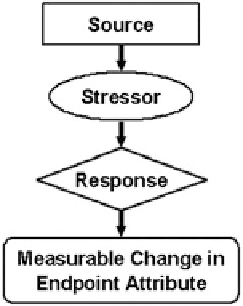Environmental Engineering Reference
In-Depth Information
Table 6.1 Steps involved in a watershed ecological risk assessment framework (USEPA
2007
)
Step 1: Problem formulation
Translate proposed use into a goal and objectives
Develop conceptual model
Identify assessment endpoints and measures of impacts
Step 2: Risk analysis
Evaluate stressors, pathways, and measures of impacts
Use reference conditions and watershed data to determine effects on assessment endpoints
Step 3: Risk characterization
Compare stressor levels and physicochemical regimes with minimum thresholds or criteria for
assessment endpoints
Determine relevant causes of nonattainability; stressor identi
cation evaluation
Step 4: Risk management
Identify control options if applicable
Consider feasibility of speci
c controls
Conduct stakeholder discussions and management option evaluation
Modify the plan if necessary
Fig. 6.1 Elementary
conceptual model (USEPA
2007
)
As an example, Table
6.2
shows the application of the assessment endpoints to
respond to the stressors in the Waquoit Bay watershed.
1
A scoring approach is
applied to evaluate the priority of stressors in the Waquoit Bay assessment. Pro-
fessional judgment is used to rank the effects of stressors on identi
ed assessment
endpoints (Serveiss et al.
2004
). Through the matrix given in Table
6.2
, the risks
associated with various stressors and their impacts can be estimated in a quantitative
manner. Assessment endpoint can translate environmental management goals into a
measurable system of attributes.
1
See
http://cfpub.epa.gov/ncea/cfm/recordisplay.cfm?deid=162845
for a further description.
















Search WWH ::

Custom Search